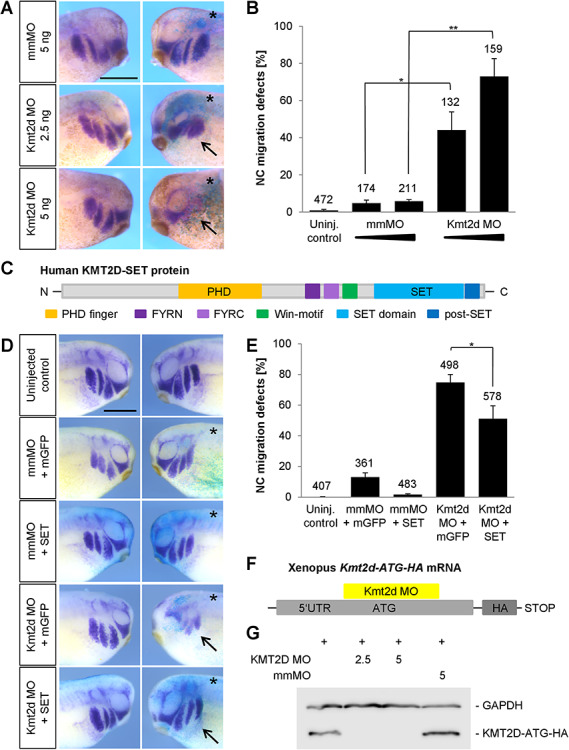Figure 2.

Kmt2d is required for cranial NC cell migration. (A) Embryos were injected with 2.5 or 5 ng mmMO or Kmt2d MO and 100 pg lacZ mRNA into one blastomere at the two-cell stage. At stage 27 NC migration was analyzed by twist whole mount in situ hybridization. Kmt2d loss-of-function leads to an inhibition of NC migration (arrows), compared to mismatch controls. The injected side of the embryo is marked (asterisk). Scale bar = 500 μm. (B) Graph summarizing the data from three independent experiments; ±SEM and the number of analyzed embryos are indicated for each condition. A two-tailed unpaired Student’s t-test was applied. (C–E) Rescue experiments. (C) Schematic view of motifs and functional domains of the human KMT2D-SET construct used for rescue experiments. (D) Embryos were injected into one blastomere at the two-cell stage with 3 ng mmMO or Kmt2d MO in combination with 400–500 pg mGFP or KMT2D-SET mRNA and 100 pg lacZ as a lineage tracer. NC migration was analyzed by twist in situ hybridization at stage 25. Overexpression of the human KMT2D-SET construct partially restores NC migration in Kmt2d morphants, compared to embryos injected with Kmt2d MO and mGFP mRNA (arrows). The injected side of the embryos is marked (asterisk). Error bar = 500 μm. (E) Graph summarizing the percentage of embryos with twist defects from six independent experiments; ±SEM and number of analyzed embryos are given for each condition. A two-tailed unpaired Student’s t-test was applied. (F) Schematic view of the Xenopus laevis Kmt2d-ATG-HA mRNA which contains the Kmt2d MO binding site. (G) To analyze the binding efficiency of the Kmt2d MO, embryos were injected at the one-cell stage with 1 ng of Xenopus Kmt2d-ATG-HA mRNA either alone or in combination with 2.5–5 ng mmMO or the translation-blocking Kmt2d MO. Protein extracts were prepared at stage 20, and the expression of Kmt2d-ATG-HA was assessed by Western Blot analysis. Injection of 2.5 and 5 ng Kmt2d MO led to a depletion of the Kmt2d-ATG-HA protein, while the expression was unaffected upon co-injection of 5 ng mmMO. GAPDH expression was used as a loading control.
